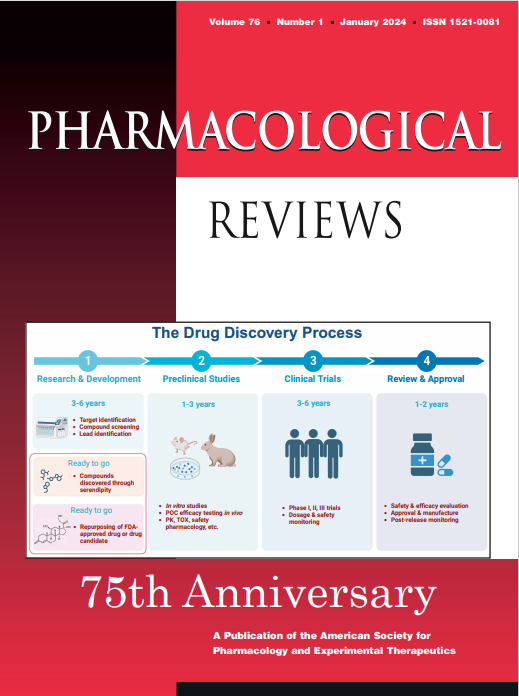酰基肉毒碱:命名、生物标志物、治疗潜力、药物靶点和临床试验
IF 19.3
1区 医学
Q1 PHARMACOLOGY & PHARMACY
引用次数: 73
摘要
酰基肉毒碱是脂肪酸代谢产物,在许多细胞能量代谢途径中发挥重要作用。它们历来被用作先天性脂肪酸氧化错误的重要诊断标志物,并作为能量代谢、线粒体和过氧化物酶体β-氧化活性缺陷、胰岛素抵抗和身体活动的标志物进行深入研究。酰基肉毒碱越来越多地被确定为许多疾病代谢研究的重要指标,包括代谢紊乱、心血管疾病、糖尿病、抑郁症、神经系统紊乱和某些癌症。美国食品和药物管理局批准的药物L-肉碱,以及短链酰基肉碱(乙酰肉碱和丙酰基肉碱),现在被广泛用作膳食补充剂。鉴于其日益重要的意义,我们对酰基肉毒碱进行了广泛的综述,并对其特性、命名、分类、生物化学、病理生理学、补充用途、潜在药物靶点和临床试验进行了详细描述。我们还在人类代谢组数据库中总结了这些更新,该数据库现在包括1240酰基肉毒碱的结构、化学式、化学/光谱特性、描述和途径的信息。这项工作为识别、表征和理解人类生物样本中的酰基肉毒碱奠定了坚实的基础。我们还讨论了使用酰基肉碱作为生物标志物以及作为许多广泛适应症的饮食干预或补充剂的新机会。还讨论了确定参与控制酰基肉碱水平的新药靶点的机会。意义声明这篇综述全面概述了酰基肉毒碱,包括它们的命名、结构和生物化学,以及作为疾病生物标志物和药物制剂的用途。我们提供了人类代谢组数据库网站中包含的最新信息,以及与酰基肉毒碱相关的已知生化途径的大量图谱,从而为进一步阐明其生理作用提供了坚实的基础。本文章由计算机程序翻译,如有差异,请以英文原文为准。
Acylcarnitines: Nomenclature, Biomarkers, Therapeutic Potential, Drug Targets, and Clinical Trials
Acylcarnitines are fatty acid metabolites that play important roles in many cellular energy metabolism pathways. They have historically been used as important diagnostic markers for inborn errors of fatty acid oxidation and are being intensively studied as markers of energy metabolism, deficits in mitochondrial and peroxisomal β-oxidation activity, insulin resistance, and physical activity. Acylcarnitines are increasingly being identified as important indicators in metabolic studies of many diseases, including metabolic disorders, cardiovascular diseases, diabetes, depression, neurologic disorders, and certain cancers. The US Food and Drug Administration-approved drug L-carnitine, along with short-chain acylcarnitines (acetylcarnitine and propionylcarnitine), is now widely used as a dietary supplement. In light of their growing importance, we have undertaken an extensive review of acylcarnitines and provided a detailed description of their identity, nomenclature, classification, biochemistry, pathophysiology, supplementary use, potential drug targets, and clinical trials. We also summarize these updates in the Human Metabolome Database, which now includes information on the structures, chemical formulae, chemical/spectral properties, descriptions, and pathways for 1240 acylcarnitines. This work lays a solid foundation for identifying, characterizing, and understanding acylcarnitines in human biosamples. We also discuss the emerging opportunities for using acylcarnitines as biomarkers and as dietary interventions or supplements for many wide-ranging indications. The opportunity to identify new drug targets involved in controlling acylcarnitine levels is also discussed. Significance Statement This review provides a comprehensive overview of acylcarnitines, including their nomenclature, structure and biochemistry, and use as disease biomarkers and pharmaceutical agents. We present updated information contained in the Human Metabolome Database website as well as substantial mapping of the known biochemical pathways associated with acylcarnitines, thereby providing a strong foundation for further clarification of their physiological roles.
求助全文
通过发布文献求助,成功后即可免费获取论文全文。
去求助
来源期刊

Pharmacological Reviews
医学-药学
CiteScore
34.70
自引率
0.50%
发文量
40
期刊介绍:
Pharmacological Reviews is a highly popular and well-received journal that has a long and rich history of success. It was first published in 1949 and is currently published bimonthly online by the American Society for Pharmacology and Experimental Therapeutics. The journal is indexed or abstracted by various databases, including Biological Abstracts, BIOSIS Previews Database, Biosciences Information Service, Current Contents/Life Sciences, EMBASE/Excerpta Medica, Index Medicus, Index to Scientific Reviews, Medical Documentation Service, Reference Update, Research Alerts, Science Citation Index, and SciSearch. Pharmacological Reviews offers comprehensive reviews of new pharmacological fields and is able to stay up-to-date with published content. Overall, it is highly regarded by scholars.
 求助内容:
求助内容: 应助结果提醒方式:
应助结果提醒方式:


